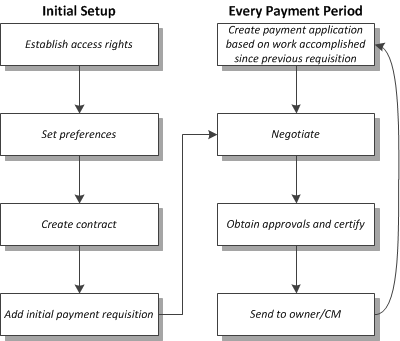Requisitions, or formal requests for payment, are usually issued by general contractors to the owner on a monthly basis as portions of work on a project are completed. Subcontractors or vendors submit requisitions to the general contractor for their portions of the work. Once the initial requisition with line items is established at the end or beginning of the next month (or other pay cycle established between the contract parties), an application for payment based on the original requisition is updated, certified, and sent. This requisition update/issuing cycle continues until the work is completed and the general contractor has been paid in full in accordance with the contract agreement.
Requisitions are based on a contract or purchase order established in Contract Management for the project. You can use lump sum and/or unit price line items from the contract or purchase order to automatically create the requisition schedule of values. As the project progresses, a requisition is issued each pay period to the owner from the general contractor for completed work. The line item or lump sum costs are negotiated until a payment agreement is reached and the requisition is approved and certified. Line item costs can be distributed to the Cost Worksheet. (Using the Cost Worksheet is optional.) When you are ready for the final copy, use Contract Management to print the form for the necessary signatures and certification.
This requisition update/issuing cycle continues until the work is completed and the GC and subcontractors have been paid in full in accordance with the contract agreement. The following diagram illustrates a typical cycle.

Materials for delivery and approved change orders applicable to each period are collected and added to the corresponding requisition. In addition, the predetermined retainage calculation per line item or percent complete is applied to the current amount due.
Legal Notices
Copyright © 2015,
Oracle and/or its affiliates. All rights reserved.
Last Published Wednesday, June 17, 2015